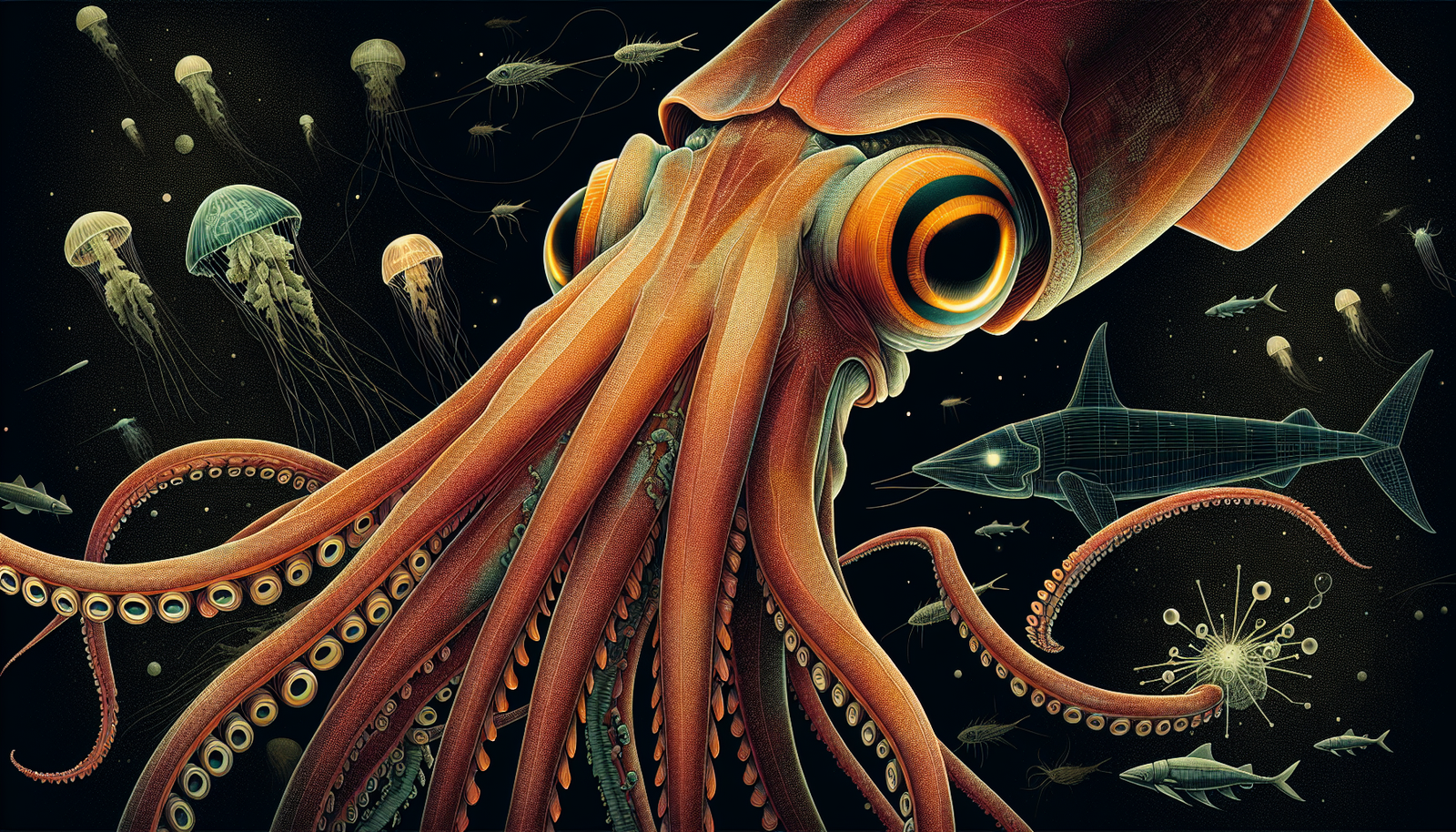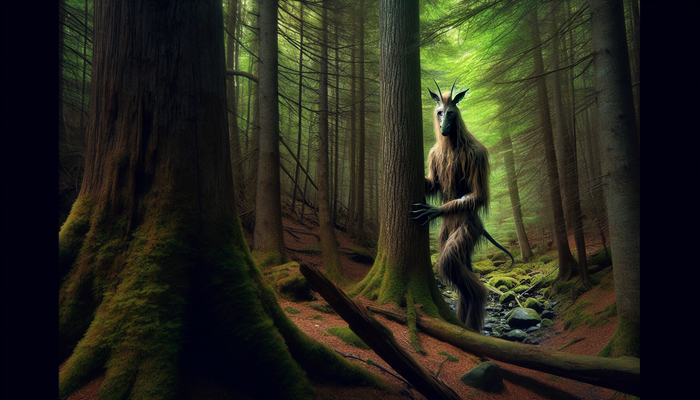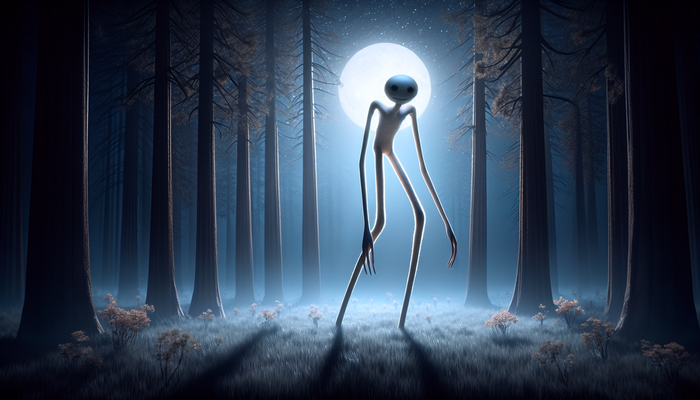Everything You Ever Wanted to Know About the Colossal Squid

By Lucas Jennings, Cryptozoologist and Adventurous Naturalist
Unveiling the Real-Life Kraken
Picture this: you're a sailor in the 18th century, navigating the treacherous waters of the Southern Ocean. Suddenly, your ship is rocked by a massive force. You rush to the deck, only to be confronted by a monstrous creature rising from the depths, its enormous tentacles wrapping around your vessel, pulling it down into the abyss. This is the stuff of legends, the tale of the dreaded kraken.
But what if I told you that this mythical beast isn't entirely fiction? That lurking in the darkest depths of our oceans is a creature that, while not quite the ship-sinking behemoth of lore, is every bit as awe-inspiring and enigmatic? Enter the colossal squid (Mesonychoteuthis hamiltoni), a cephalopod of such gigantic proportions and alien features that it seems almost too bizarre to be real.
This deep-sea leviathan, with eyes the size of dinner plates and swiveling hooks lining its tentacles, has long been the subject of fascination and mystery. Despite its incredible size - it's the largest known invertebrate by mass - the colossal squid remains largely an enigma, its habits and life cycle still cloaked in the darkness of the abyss.
As a researcher who has dedicated my life to unraveling the secrets of the cryptic creatures that inhabit our planet, I find myself irresistibly drawn to the colossal squid. What secrets does this giant hold? What can its unique adaptations tell us about life in the extreme environments of the deep sea? Join me as we embark on a journey to unmask this real-life kraken and shed light on one of the ocean's most captivating mysteries.
The Colossal Squid: A Superlative Species
When it comes to size, the colossal squid truly lives up to its name. While the giant squid (Architeuthis dux) may be slightly longer, the colossal squid is far more massive. Estimates suggest that these behemoths can weigh up to 1,100 pounds (500 kg), with some experts speculating they could potentially reach 1,500 pounds (700 kg) based on analysis of beaks found in sperm whale stomachs. From the tip of its mantle to the end of its tentacles, the colossal squid can measure up to a staggering 46 feet (14 meters).
But it's not just sheer size that sets the colossal squid apart. This species boasts a collection of anatomical superlatives that make it stand out even among the ocean's most remarkable inhabitants. Perhaps most striking are its eyes, which are the largest of any animal on Earth. Measuring up to 11 inches (27 cm) in diameter, these ocular giants are thought to be an adaptation for detecting the bioluminescent glimmers of prey and the shadowy silhouettes of predators in the perpetual darkness of the deep sea.
And then there are the colossal squid's tentacles, a truly fearsome hunting apparatus. In addition to the standard eight arms found in other squid species, the colossal squid sports two long tentacles lined with swiveling hooks and three-pointed hooks, perfect for snagging and securing struggling prey. These hooks, along with the squid's robust, razor-sharp beak, make it a formidable predator capable of tackling sizable fish and even other squid species.
But perhaps one of the most intriguing aspects of the colossal squid's physiology is its unique adaptations to life in the deep sea. To maintain buoyancy in the crushing pressures of the abyss, this species has ammonium chloride in its tissues, a lighter-than-seawater solution that helps it maintain neutral buoyancy. It also has a remarkably slow metabolism, needing only about 30 grams of food per day as an adult, a testament to the energy-conserving strategies necessary for survival in the resource-scarce depths.
As I ponder these superlative traits, I can't help but be filled with a sense of awe. The colossal squid is a creature that has evolved to thrive in one of the most extreme environments on our planet, a realm of perpetual darkness, bone-crushing pressure, and scarcity. Its very existence is a testament to the incredible adaptability and resilience of life. But to truly appreciate this marvel of the deep, we must venture into its domain.
Habitat and Range: The Southern Ocean's Abyssal Depths
The icy, turbulent waters of the Southern Ocean, swirling around Antarctica, conceal a realm that is alien to us surface-dwellers. It is here, in the abyssal depths, that the colossal squid makes its home. This circumpolar habitat, with its consistently cold temperatures and unique oceanographic features, has given rise to a fascinating array of deep-sea denizens, and the colossal squid is undoubtedly one of its most captivating residents.
While adult colossal squid are most frequently encountered at depths between 1,000 and 2,000 meters, juveniles of the species are known to inhabit shallower waters. This vertical distribution is thought to be a strategy for avoiding predation and competition, with the younger, more vulnerable squid staying in the relative safety of the upper mesopelagic zone before descending into the abyssal depths as they grow and mature.
The geographic range of the colossal squid is believed to extend from the waters directly adjacent to Antarctica to the southern tips of continents like South America, Africa, and New Zealand. However, due to the inherent challenges of studying creatures that inhabit such remote and inaccessible environments, the full extent of their distribution remains uncertain.
As I contemplate the vastness of the Southern Ocean and the depths at which the colossal squid resides, I can't help but feel a sense of humility. We have only begun to scratch the surface of these abyssal realms, and the colossal squid serves as a poignant reminder of how much we have yet to discover. Each deep-sea expedition, each remote-operated vehicle dive, has the potential to reveal new insights into the lives of these enigmatic creatures and the complex ecosystems they inhabit.
But the colossal squid is more than just a passive inhabitant of these deep, dark waters. It plays an active and vital role in the Southern Ocean's food web, a role that we are only beginning to understand.
Feeding Habits and Ecological Role
In the perpetual darkness of the deep sea, the colossal squid is a master of ambush. With its keen eyes and powerful tentacles, it lies in wait for unsuspecting prey to venture within striking distance. When the moment is right, it unleashes a lightning-fast attack, using its swiveling hooks to snag its target and its serrated beak to tear the struggling victim into manageable pieces.
The diet of the colossal squid is thought to consist primarily of fish, particularly the Patagonian toothfish and other large, deep-sea species. However, evidence suggests that they are not above cannibalism, with remains of other colossal squid occasionally found in the stomachs of captured specimens. This propensity for intra-species predation may be a reflection of the fierce competition for resources in the sparse environment of the abyss.
But the colossal squid is not just a predator; it is also an important prey species for some of the Southern Ocean's most iconic inhabitants. Chief among these is the sperm whale, a deep-diving leviathan known to plunge to depths of over 2,000 meters in pursuit of squid. Analysis of sperm whale stomach contents has revealed a high frequency of colossal squid beaks, indicating that these cephalopods form a significant part of their diet.
The interactions between colossal squid and sperm whales are the stuff of legend. Many sperm whales bear scars on their skin, telltale signs of the battles that take place in the depths. The giant squid's swiveling hooks, normally used for capturing prey, become defensive weapons, leaving their mark on the whales that attempt to make a meal of them. It's a stark reminder that in the deep sea, the line between hunter and hunted is often blurred.
Other predators, such as sleeper sharks and southern elephant seals, are also known to feed on colossal squid, particularly juveniles and smaller individuals. The role that this species plays in the diets of these animals and the larger deep-sea food web is still an area of active research, but it is clear that the colossal squid is a key player in the complex ecological interactions of the Southern Ocean.
As I reflect on the colossal squid's place in this intricate web of life, I am struck by the delicate balance that exists in these deep-sea ecosystems. Each species, no matter how strange or monstrous it may seem to us, has a part to play in maintaining the health and stability of the whole. But there is still so much we don't know about how these relationships are forged and maintained, particularly when it comes to the most elusive of creatures, like the colossal squid.
Life Cycle and Reproduction: Mysteries in the Deep
One of the most tantalizing aspects of the colossal squid's biology is its life cycle and reproductive habits. Due to the extreme difficulties in studying these animals in their natural habitat, much of what we know is based on inference and comparison to better-known squid species.
It is thought that colossal squid, like many of their cephalopod cousins, have a relatively short lifespan, perhaps on the order of a few years. This is in keeping with the "live fast, die young" strategy employed by many deep-sea organisms, where the challenges of the environment necessitate a focus on rapid growth and reproduction.
In terms of reproductive biology, the colossal squid is believed to exhibit sexual dimorphism, with females growing significantly larger than males. This size disparity is thought to be related to the energy demands of producing the large numbers of eggs needed to ensure successful reproduction in the harsh conditions of the deep sea.
While the specifics of colossal squid mating behavior have never been directly observed, it is likely that they engage in a modified version of the elaborate courtship rituals seen in other squid species. Males probably use their specialized tentacles to transfer spermatophores (packets of sperm) to the female, who then uses them to fertilize her eggs.
The early life stages of the colossal squid are equally shrouded in mystery. Based on the patterns seen in other deep-sea cephalopods, it is hypothesized that juvenile colossal squid inhabit the upper reaches of the water column, where food is more abundant and predation pressure is lower. As they grow and mature, they gradually descend into the abyssal depths, taking up the solitary, ambush-predator lifestyle of the adults.
But these are all educated guesses, pieced together from fragments of data and the occasional lucky observation. The truth is, the colossal squid's reproductive cycle and early life history remain one of the great unsolved mysteries of deep-sea biology. Every new discovery, every fortuitous encounter with a juvenile or egg-laden female, has the potential to revolutionize our understanding of this enigmatic species.
As a researcher, I find this lack of knowledge both frustrating and exhilarating. On one hand, it is a stark reminder of how much we still have to learn about the denizens of the deep. But on the other, it represents an incredible opportunity for discovery, a chance to shed light on a facet of the natural world that has long been hidden from view. Each new piece of the puzzle, no matter how small, brings us one step closer to understanding the complex tapestry of life in the abyss.
Discovery and Scientific Study
The colossal squid, for all its mystery and enigma, is not a recent discovery. Tales of giant squid-like creatures have been a part of maritime lore for centuries, with ancient accounts of tentacled beasts dragging ships to their doom. But it wasn't until 1925 that the colossal squid was officially recognized by science, when two tentacle crowns were found in the stomach of a sperm whale.
Since then, our encounters with this elusive species have been few and far between. The vast majority of specimens have been the result of accidental captures by deep-sea trawlers or the occasional beached carcass. Intact adult specimens are particularly rare, with most of our knowledge coming from partial remains and immature individuals.
One of the most notable specimens was captured in 2007 in the Ross Sea, off the coast of Antarctica. This massive individual, weighing in at over 1,000 pounds (450 kg), was taken to the Museum of New Zealand Te Papa Tongarewa for study and preservation. The examination of this specimen yielded a wealth of new data on the species' anatomy and biology, including insights into its reproductive system and digestive tract.
But for every question answered by these rare specimens, a dozen more are raised. How do colossal squid locate and capture their prey in the darkness of the deep sea? What is the nature of their interactions with other denizens of the abyss? How do they navigate the complex currents and topography of their habitat? These are the kinds of questions that drive marine biologists and deep-sea researchers, the tantalizing mysteries that keep us searching the depths.
In recent years, advances in deep-sea exploration technology have opened up new frontiers in the study of creatures like the colossal squid. Remote-operated vehicles (ROVs) and autonomous underwater vehicles (AUVs) allow us to probe the depths in ways that were once impossible, capturing high-resolution images and video of the abyssal realm and its inhabitants. Genetic sequencing and stable isotope analysis are providing new insights into the evolutionary history and ecological roles of deep-sea species.
Yet even with these tools at our disposal, the colossal squid remains an elusive quarry. Every successful study, every new specimen, is a hard-won victory against the challenges of the deep. But it is a battle that we must continue to fight, for the secrets that the colossal squid holds are not just academic curiosities. They are windows into the functioning of one of the largest and least-understood ecosystems on our planet, a realm that is increasingly under threat from human activities.
Conservation and Human Interactions
Despite its fearsome reputation and impressive size, the colossal squid is not invulnerable to the pressures facing the world's oceans. Like many deep-sea species, it is potentially vulnerable to the impacts of commercial fishing, particularly the deep-sea trawling operations that scour the ocean floor in search of valuable fish stocks.
While colossal squid are not directly targeted by any fishery, they can be caught accidentally as bycatch in deep-sea trawl nets. The extent of this impact is difficult to quantify, as most of these incidental captures likely go unreported. However, given the species' relatively low reproductive rate and the delicate balance of deep-sea ecosystems, even small levels of additional mortality could have significant consequences.
Climate change is another looming threat to the colossal squid and its abyssal habitat. As global temperatures rise, the ocean is absorbing much of the excess heat, leading to changes in water temperature, chemistry, and circulation patterns. These shifts can have cascading effects on deep-sea communities, altering food web dynamics and species distributions in ways that are still poorly understood.
The challenges in studying and protecting deep-sea species like the colossal squid are immense. The sheer inaccessibility of their habitat, combined with the high costs and technical difficulties of deep-sea research, make it difficult to gather even basic data on their populations and ecology. Without this information, it is hard to assess their conservation status or develop effective management strategies.
But perhaps the greatest challenge is one of public perception and awareness. For most people, the deep sea is out of sight and out of mind, a realm so alien and remote that it might as well be on another planet. Creatures like the co
From Bigfoot to UFOs: Hangar 1 Publishing Has You Covered!
Explore Untold Stories: Venture into the world of UFOs, cryptids, Bigfoot, and beyond. Every story is a journey into the extraordinary.
Immersive Book Technology: Experience real videos, sights, and sounds within our books. Its not just reading; its an adventure.



























